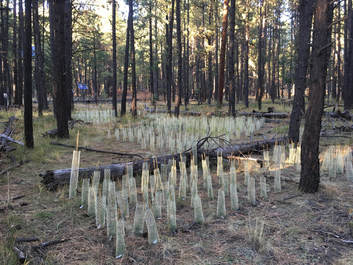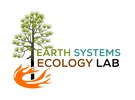Quantifying the effects of species range shifts and management of post-fire recovery on regional carbon dynamics in a changing climate
 Common garden planting at ponderosa pine site
Common garden planting at ponderosa pine site
Funding Source: USDA NIFA, Interagency Carbon Cycle Science
Research Team: Matthew Hurteau, Dan Krofcheck, Marcy Litvak, Scott Collins
Objective: Semi-arid ecosystems play a dominant role in governing the trend and interannual variability of the land carbon (C) sink at global scales and source-sink dynamics in these biomes are a function of interannual climatic variability and disturbance. In the southwestern US, regional climate models project warmer temperatures, decreased winter precipitation, and more variable summer rainfall regimes, patterns that are already evident in the recent past. As a consequence, widespread conifer mortality is projected for this region, driven by increasing aridity and severe, climate change type droughts. Widespread conifer mortality has the potential to substantially alter C cycle dynamics and terrestrial C cycle feedbacks to the atmosphere. While widespread conifer mortality is projected for the future, larger, hotter wildfires are already driving vegetation changes in many semi-arid systems. Coupled with changing climate, wildfires could serve to catalyze shifts in vegetation types towards ecosystem compositions with a lower carbon state. The overarching goal of our proposed research is to understand how potential changes in species range distributions and post-fire establishment success will affect regional carbon dynamics in the southwestern US under future climate change scenarios.
This research will answer three primary questions:
This research is being conducted at three field locations in New Mexico and simulations will be focused on a large landscape in northern New Mexico.
Research Team: Matthew Hurteau, Dan Krofcheck, Marcy Litvak, Scott Collins
Objective: Semi-arid ecosystems play a dominant role in governing the trend and interannual variability of the land carbon (C) sink at global scales and source-sink dynamics in these biomes are a function of interannual climatic variability and disturbance. In the southwestern US, regional climate models project warmer temperatures, decreased winter precipitation, and more variable summer rainfall regimes, patterns that are already evident in the recent past. As a consequence, widespread conifer mortality is projected for this region, driven by increasing aridity and severe, climate change type droughts. Widespread conifer mortality has the potential to substantially alter C cycle dynamics and terrestrial C cycle feedbacks to the atmosphere. While widespread conifer mortality is projected for the future, larger, hotter wildfires are already driving vegetation changes in many semi-arid systems. Coupled with changing climate, wildfires could serve to catalyze shifts in vegetation types towards ecosystem compositions with a lower carbon state. The overarching goal of our proposed research is to understand how potential changes in species range distributions and post-fire establishment success will affect regional carbon dynamics in the southwestern US under future climate change scenarios.
This research will answer three primary questions:
- How do topography and fire severity interact to affect the spatial arrangement of vegetation across the landscape, and what implications does that have for changes in surface radiation energy balance and water availability for seedlings?
- Given 1, where on the landscape is seedling survival most probable and how does species selection for reforestation efforts alter survival probability?
- How do post-fire reforestation efforts using climate-adapted species alter future carbon dynamics across the landscape?
This research is being conducted at three field locations in New Mexico and simulations will be focused on a large landscape in northern New Mexico.
